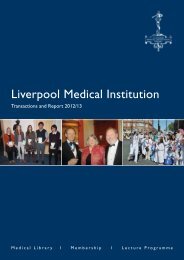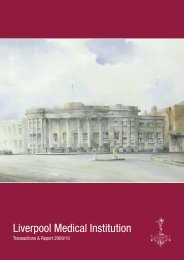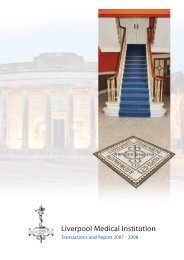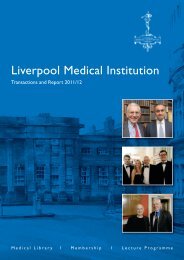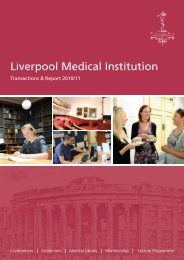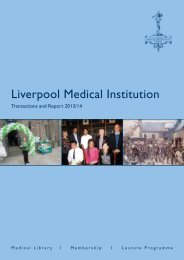LMITransactions&Report2014-15
Create successful ePaper yourself
Turn your PDF publications into a flip-book with our unique Google optimized e-Paper software.
LMI Transactions and Report 2014 - 20<strong>15</strong><br />
components of cardiac output to improve heart<br />
failure. Most devices were battery operated with<br />
leads to the appropriate areas of the heart. The leads<br />
were able to sense cardiac electrical impulses and<br />
deliver an appropriate electrical stimulation.<br />
The majority of pacemakers inserted are dual chamber<br />
with leads to both atria and ventricle. Single chamber<br />
pacing is occasionally indicated in the atrium for sinus<br />
node dysfunction with normal atrio-ventricular<br />
conduction or ventricular pacing only for ventricular<br />
rate control resistant atrial fibrillation. Cardiac<br />
function is best maximised by efficient synchronised<br />
atrial and ventricular activity. The existence of an<br />
intraventricular bundle branch block results in<br />
dysfunctional ventricular activity, in particular a left<br />
bundle branch block gives rise to a dysfunctional left<br />
ventricular contraction. In the past, pacing of the<br />
right ventricle mimicked a left bundle branch block<br />
and subsequent inefficient activity. This could be<br />
overcome by pacing the posterolateral wall via the<br />
coronary sinus requiring a 3 lead pacemaker.<br />
Ventricular tachycardia or ventricular fibrillation is<br />
amongst the commonest cause of sudden cardiac<br />
death. Modern devices are able to sense ventricular<br />
tachycardia or ventricular fibrillation to terminate it<br />
and pace the ventricles. Unfortunately this technique<br />
does not work for atrial fibrillation. Ventricular shock<br />
so delivered can be painful but this is a relatively small<br />
price. Dr Snowdon continued by briefly describing the<br />
technique involved in the insertion of such devices.<br />
The heart is approached from the systemic venous side<br />
and a subcutaneous pocket is developed for the device<br />
itself. Leads are of either a corkscrew or a grappling<br />
hook type of end, which engages with the<br />
trabeculations within the heart. Subcutaneous<br />
defibrillation devices for ventricular tachycardia or<br />
ventricular fibrillation have no intracardiac lead.<br />
Intracardiac leads are continually moving and<br />
therefore can become broken or moved from the<br />
implanted position. Such devices will deliver a shock<br />
to revert VT or VF but can only give rescue pacing.<br />
Sudden cardiac death is usually of arrhythmic origin.<br />
Implanted defibrillators do make patients live longer<br />
but the anxiety about such attacks of VT or VF does<br />
remain. In the presence of known episodes the risk of<br />
death in five years, if untreated, is around 50%, and<br />
the chance of surviving cardiac death outside hospital<br />
is around 5%. In the presence of a known chance of<br />
catastrophic arrhythmia implanted defibrillators<br />
present a significant risk improvement. Life<br />
expectancy is improved. Inappropriate shocks are<br />
rare. Battery life of such devices is 5-8 years.<br />
Indications for such devices are a known arrhythmic<br />
problem, either familial or acquired with improved<br />
long term survival following surgery for congenital<br />
heart disease. Right ventricular failure can also present<br />
an arrhythmic risk. The long term outcomes for the<br />
different groups are obviously variable.<br />
In the investigation of arrhythmias and syncope<br />
attacks, external monitoring devices have a limited<br />
use. Implantable loop recorders are capable of<br />
monitoring for up to three years and usually record a<br />
7-10 minute cycle overwritten if no event occurs. They<br />
may be interrogated transcutaneously by telephone<br />
without the necessity for visiting the monitoring<br />
centre.<br />
In recent years there have been significant<br />
advancements in the scope of the use of such devices.<br />
The risk of lead failure is now very low, battery life is<br />
extended considerably and sophisticated electronics<br />
are capable of sophisticated tasks. Although the<br />
presence of an implanted device does improve patient<br />
outlook, it is apparent that not all anxiety from<br />
knowledge of the underlying condition is removed,<br />
and patients continue to need significant<br />
psychological support which at present is ill resourced.<br />
The President thanked the two speakers from the<br />
Liverpool Heart and Chest Hospital.<br />
R Franks<br />
24






